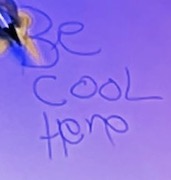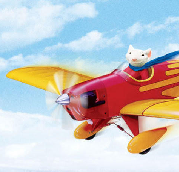|
PT6A posted:Now, let's talk about crosswind control. Ugh. I'm actually pretty good at intuitively crabbing while in the air. Instructor really likes wing-low for landing, and that's messing with me in that same 'don't slam the wingtip off the ground' sense
|
|
|
|

|
| # ? Jun 2, 2024 18:56 |
|
 free vacation before starting new job, let's finish these hours free vacation before starting new job, let's finish these hoursFirst booking: lovely day, solo hours finished Second: lovely morning, lesson canceled, rest of day gorgeous Third: lovely day, plane in maintenance Last: storms forecast A story of my training in four acts
|
|
|
|
dupersaurus posted:
find/replace "training" with "instructing" and... exactly the same
|
|
|
|
vessbot posted:But how smoothly? How should he know if his version of "smooth" is too fast or too slow? By watching the video I linked.
|
|
|
|
e.pilot posted:By watching the video I linked. It doesn't answer the question, though. It talks about when to start the flare, not how quickly to pull the nose up toward the touchdown attitude once the flare has started. (Unless it goes further after the part with the robot voice starts, when I turned it off as it went into a different topic alltogether.)
|
|
|
|
Itís impossible to put a tangible number on that because every landing is a little bit different. Thatís where practice and experience comes in, and getting help from your CFI, until itís perfected. Having the sight picture down and knowing what to look for helps with getting the feel down. How long that takes depends on the person.
|
|
|
|
e.pilot posted:Itís impossible to put a tangible number on that because every landing is a little bit different. Thatís where practice and experience comes in, and getting help from your CFI, until itís perfected. Having the sight picture down and knowing what to look for helps with getting the feel down. How long that takes depends on the person. Well no, it's totally possible to have a tangible procedure that meets the goal while responding to the differences between each landing; and I laid one out just a few posts up. "Practice" is senseless (literally) unless one is aware of the mechanics of the tasks he is practicing. Otherwise, what is this practice supposed to consist of? Pulling on the stick over and over till he gets lucky? And after that what, keep pulling over and over until he gets lucky again? And then again and again until the lucky results start lining up in long enough streaks to call it OK? What helpful thing is the instructor supposed to say? "Knowing what to look for" is key and I said what to look for, all of which you ignored when saying simply to smoothly put the cowl on the horizon. Well, that by itself doesn't work, and I also explained why it doesn't work. And others have chimed in as to how they had fallen into the same trap in the past. yellowD posted:Wow, thanks everyone. There's a lot here for me to digest and try on Saturday. Two more things I was gonna mention. First is putting it all even more succinctly, which is that the goal is to fly formation with the ground until you almost run out of elevator authority. Second (and this has come up before ITT) is that a great exercise to do is a low pass over the runway, at a slow to medium speed, a few feet high, with the goal of neutralizing vertical disturbances and maintaining the height. Now, this lets you practice this "flying formation with the ground" phase instead of 4-5 seconds (in an actual landing), to, say, 40-50 seconds. Now you can get some actual dedicated practice at just this task. A huge problem with learning flying is that for so many things, you're having to do multiple tasks, each of which is brand new, either simultaneously or in rapid fire succession.... which, needless to say, is very difficult. So I find any opportunity that I can to isolate them, and this exercise is one such way. In the few seconds of a normal flare, you barely have time to start engaging your brain into this task, and by the time you do it's over and you touch down (or balloon); and it's immediately on to the next task so you don't have time to reflect. But with some dedicated practice over the whole length of the runway, you actually have time to engage, and within one pass get the chance to see some deviations, the amount of airplane response to your responses to those deviations, and recalibrate yourself so you handle the next few better, etc. One of the teaching experiences that sticks out the most in my mind is doing this exercise with a tailwheel student who was already a private pilot. I said "OK, I'll have the throttle, we're gonna fly down to about 5 feet AGL and I just want you to maintain that height. We'll go around when close to the far end." What I saw next stunned me. I got it stabilized and gave him the controls, and we immediately started sinking toward the ground, clearly about to touch down, with no sign of a correction from him. We hit the ground on the mains (I allowed this to happen since it was a taildragger, this would have collapsed the nosegear and/or struck the prop in a tricycle) and bounced up, and on our way up there was not the smallest correction either. We arced up to 50 feet when we ran out of speed and started diving again, with, again, no attempt to arrest the descent. We would have hit too hard this time, so I ended the exercise. Now of course I don't expect perfection from somebody's first try at anything (an adept student should be able to hold about a foot of tolerance) but this guy didn't hold even a few feet, not even 10 feet. There was not even an attempt, just... nobody home. In his brain, conscious or unconscious, there was no concept of holding a height (not referencing the altimeter.) There was no closed loop control, all of his previous landing experience must have been just an open-loop programmed sequence of "do X with the stick at Y time" that, starting from hopefully a set energy state at the start of the flare, ended up plopping him on to the runway somehow. To generalize this into some flying philosophy... if you're not an engineering type of person, something to take in is the concept of "closed loop control," or comparing the actual result of an action with the expected result, and, whatever the difference is, repeating the same type of action (back at the beginning of the "loop") to shrink this difference. You again compare the expected vs. actual, and ideally the difference is zero, i.e., you accomplished what you wanted. If it's not zero, you go back to the beginning, and keep repeating. A basic everyday example of this is a thermostat, which continually compares the set temp vs. the actual temp, and puts warmer/cooler air in the room to drive this difference to zero. More relevant is, say, an autopilot in altitude hold mode. It continuously compares the selected altitude vs. the actual, and pitches up or down in response to this difference to drive it to zero. In this exercise, you're doing the same thing as the altitude autopilot is, except the input is from your eyes over the runway instead of barometric. And a ton of things in flying are like that. Some talk was made earlier of crosswind inputs. "How much rudder do I put in?" However much it takes to ensure the nose is pointing where you want, i.e., straight ahead. "How much aileron do I put in?" However much it takes to ensure your position is where you want, i.e., over the centerline. Etc. A mediocre pilot, in these situations (and many others) will just put in some predetermined amount of control, accept (not even consciously accept, just, it's what happens) what happens and let it ploink on. If it's a crosswind landing and you're only a few degrees crooked, and it's a tricycle, this pilot will accept this without even realizing that anything was wrong, and go through a whole career of thinking this is OK. A good pilot, OTOH, goes through the closed loop many times per second, for each relevant parameter, and re-processes how much input is needed. vs. where the nose is pointing (or whatever.) --- Now, for those who might miss the nuance, I'm gonna risk belaboring the point here: With experience, both the closed-loop and open-loop mindsets should be at work simultaneously. Of course I don't re-measure how much pull force I use in the flare, from scratch, for every landing. Experience teaches me a rough predetermined amount that I start with. (If I disregarded this experience, it would be like I'm landing the airplane for the first time every time.) This is the "muscle memory." However, I reemphasize that this only a rough pre-plan (open loop) and once the maneuver has started, I go into closed-loop mode and keep reevaluating the result, and readjust accordingly. If I didn't, then if I started the flare with a few extra knots, or hit a headwind or upgust, or accidentally jiggled the stick back, or the CG was further back than normal, or any of a myriad of other causes for a deviation, I'd balloon.
|
|
|
|
vessbot posted:To generalize this into some flying philosophy... if you're not an engineering type of person, something to take in is the concept of "closed loop control," or comparing the actual result of an action with the expected result, and, whatever the difference is, repeating the same type of action (back at the beginning of the "loop") to shrink this difference. You again compare the expected vs. actual, and ideally the difference is zero, i.e., you accomplished what you wanted. If it's not zero, you go back to the beginning, and keep repeating. A basic everyday example of this is a thermostat, which continually compares the set temp vs. the actual temp, and puts warmer/cooler air in the room to drive this difference to zero. More relevant is, say, an autopilot in altitude hold mode. It continuously compares the selected altitude vs. the actual, and pitches up or down in response to this difference to drive it to zero. In this exercise, you're doing the same thing as the altitude autopilot is, except the input is from your eyes over the runway instead of barometric. Stealing this explanation, thanks!
|
|
|
|
I think a lot of instructors tend to "overteach" landings. They try to give students a route procedure to follow. Reduce power at xxx height, flare at this sight picture, take 10 seconds to transition from a descent to a Vy pitch attitude, ect. Students love this sort of this thing and will latch on to it but then become frustrated when it produces wildly inconsistent results because there's no route procedure that works for every landing. Near the end of my CFI career my "how to land" ground lesson was a total of about 10 minutes and basically consisted of "do a power off stall as close to the ground as possible without actually touching it." Followed by a few tips about sight picture, crosswinds, and power usage. I made sure to emphasize that they were just tips and if they wern't working out to just ignore them and do whatever they needed to do to land. Switching to this from the hour long dissertation I used to give was amazingly helpful in getting my students to actually fly the airplane rather than apply a landing "procedure."
|
|
|
|
|
KodiakRS posted:I think a lot of instructors tend to "overteach" landings. They try to give students a route procedure to follow. Reduce power at xxx height, flare at this sight picture, take 10 seconds to transition from a descent to a Vy pitch attitude, ect. Students love this sort of this thing and will latch on to it but then become frustrated when it produces wildly inconsistent results because there's no route procedure that works for every landing. Near the end of my CFI career my "how to land" ground lesson was a total of about 10 minutes and basically consisted of "do a power off stall as close to the ground as possible without actually touching it." Followed by a few tips about sight picture, crosswinds, and power usage. I made sure to emphasize that they were just tips and if they wern't working out to just ignore them and do whatever they needed to do to land. Switching to this from the hour long dissertation I used to give was amazingly helpful in getting my students to actually fly the airplane rather than apply a landing "procedure." I think it also depends on the student -- every student will have different problems with the approach and landing, so after the first lesson of circuits, you have to figure out their strengths and weaknesses and focus future teaching on that student's specific weaknesses. A student who's having trouble setting up consistent approaches and landings might need more focus on the open-loop starting procedures. A student who's consistently lining up to the left or right of centerline might need more focus on establishing the proper sight picture early in the approach. A student who's shooting consistent approaches but having trouble transitioning to good flares and landings might need more focus on judging conditions and responding appropriately. God knows I haven't taught too many students, but in comparison to some other phases of training, no two students so far have had the same difficulties with approaches and landings. With steep turns or slow flight, or even just basic level-offs, I see the same two or three mistakes over and over and I know how to correct them; with circuits, there's so much going on that the range of possible problems and solutions is far larger and more challenging to deal with as an instructor.
|
|
|
|
Hello, aviation thread. I have a flying-related question that seems like it might be good to ask here, even though it's as a passenger not a pilot. Any tricks to deal with ear pain while flying? When I'm on a flight my ears pop like anyone else, but on descent the pain gets real bad, like "pencil shoved into my ear canal" bad. Had an uncle who was in the Air Force advise me to take sudafed for 24 hours leading up to my flight, which helps, but only some of the time. I figure since everyone here is in the air so much, there might be another remedy to pass along? Or just ignore this and talk about actually important poo poo, whatever.
|
|
|
|
The pain on descent occurs because the pressure outside your ears is greater than that inside. Have you tried "exhaling" (carefully) with your mouth closed and nose held to force air into your ears and equalize the pressure? That always works for me. Just do it slowly so that you don't blow them out the other way.
|
|
|
|
KodiakRS posted:I think a lot of instructors tend to "overteach" landings. They try to give students a route procedure to follow. Reduce power at xxx height, flare at this sight picture, take 10 seconds to transition from a descent to a Vy pitch attitude, ect. Students love this sort of this thing and will latch on to it but then become frustrated when it produces wildly inconsistent results because there's no route procedure that works for every landing. Near the end of my CFI career my "how to land" ground lesson was a total of about 10 minutes and basically consisted of "do a power off stall as close to the ground as possible without actually touching it." Followed by a few tips about sight picture, crosswinds, and power usage. I made sure to emphasize that they were just tips and if they wern't working out to just ignore them and do whatever they needed to do to land. Switching to this from the hour long dissertation I used to give was amazingly helpful in getting my students to actually fly the airplane rather than apply a landing "procedure." This guy teaches. Sure I could go into all the intricacies and talk about landings for hours, but that means next to nothing to someone whoís already overwhelmed with trying to learn how to land. Keep it simple and easy to remember so the student isnít trying to recall every little tidbit and intricacy in the round out and flare, thereís too much happening too quickly to do it by rote memorization. Save the theory and deep dive for the commercial student thatís trying to absolutely perfect their landings, not the private pilot thatís just trying to safely and consistently land. ďsmoothly pulling the cowl to the horizonĒ is not and does not need a hard definition, youíre not practicing and learning how to land in a vacuum, thatís why the CFI is there to demonstrate what a proper round out and flare look like. Once a student has the muscle memory of what smoothly pulling to the horizon looks and feels like, it works in every situation. Not second guessing and trying to robotically go through it thinking ďoh my CFI said to do this if Iím heavyĒ or ďdo this if itís a strong headwindĒ or ďoh no I came in a little fast, what did my CFI say the differences would be?Ē Just the same sight picture and feel, every time. Hell Iíll spend more time teaching how to set up a stabilized approach than I do the actual act of landing. A good landing starts on the downwind when initiating the descent. That and a stabilized approach can absolutely be flown by the numbers. e: mactheknife posted:Hello, aviation thread. I have a flying-related question that seems like it might be good to ask here, even though it's as a passenger not a pilot. Google the Valsalva maneuver, essentially hold your nose and blow air into your sinuses. That and try chewing gum. e.pilot fucked around with this message at 19:07 on Apr 12, 2019 |
|
|
|
e.pilot posted:Google the Valsalva maneuver, essentially hold your nose and blow air into your sinuses. That and try chewing gum. Itís worth noting that the Valsalva Maneuver doesnít work for some people. When I dive or fly, pretty much only the Lowry technique works for me without fail. Your mileage may vary. The diving-specific tips arenít particularly useful here, but this page lists all the different ways to force your eustachian tubes open enough to equalize.
|
|
|
|
Thanks all - I've tried Valsalva before but it doesn't do much once it gets that bad, most of the common things don't do much for it. It's been a few years since I flew, so who knows if it'll be bad or worse for my upcoming trip. Wanted to know if there were any s e c r e t methods pilot-types knew. Appreciate the assist!
|
|
|
|
mactheknife posted:Thanks all - I've tried Valsalva before but it doesn't do much once it gets that bad, most of the common things don't do much for it. It's been a few years since I flew, so who knows if it'll be bad or worse for my upcoming trip. Wanted to know if there were any s e c r e t methods pilot-types knew. Appreciate the assist! Constantly wiggle your jaw back and forth and forward and back. It's harder to equalize the pressure once the problem is already bad, so you just have to do it as often as possible.
|
|
|
mactheknife posted:Wanted to know if there were any s e c r e t methods pilot-types knew. Appreciate the assist! FAA approved drugs. If those don't work; calling in sick.
|
|
|
|
|
Re: Overteaching I'm not a CFI, but I am an instructor and I spend all day teaching students the technical aspects of a technical skill. I've seen algorithmic teaching from some of my colleagues and it just creates a mediocre to well functioning robot. I've tried very hard to teach the same concepts conceptually, rather than saying "Do this because that's what you do." The result is someone who can make the right decision in a multitude of situations rather than just in the canned situations presented in training. I've found that a student who understands the concepts and can apply some critical thinking to get to the right answer will be more proficient in the end. There are absolutely parts of flying that have hard and fast numbers, but I think a PPL student could benefit from some seat of the pants flying or feeling the airplane. The how fast to flare or how much rudder/aileron in a crosswind issues are good examples. During my PPL training, I bounced back and forth between two instructors. One was a good ol' boy who'd been flying for years and the other was an active duty F15 pilot. Both had different styles of instruction (feeling the plane vs. do this at that stage of flight), and I while I think I benefited from both methods I learned more from "feeling" the airplane.
|
|
|
|
I'm so loving relieved. Opened today with the perfect low approach, followed by 5 or 6 of the best landings I've ever done. CFI said a few were perfect, almost greasers. Thank you goons
|
|
|
|
yellowD posted:I'm so loving relieved. Opened today with the perfect low approach, followed by 5 or 6 of the best landings I've ever done. CFI said a few were perfect, almost greasers. Bless up my guy. 
|
|
|
|
Well I have some good news and some bad news about this new "closed-loop mindset" metaphor, approach. On the plus side, I have better insight into why my student is loving up. On the minus side, this insight has not helped my student. "Look at how the plane is pointing to the left side of the runway, you need to apply more right rudder" in the flare was met with FULL RIGHT RUDDER, ALL THE RIGHT RUDDER, a bizarre touchdown, and the soft weeping of an instructor at the end of his rope. I don't think we managed to get a properly aligned landing the whole flight, and I just don't know where to go from here. This is a particularly new weakness for this guy, and believe you me, he did not need any more weaknesses. I'm going to cover up all his instruments, minus altimeter, tomorrow and see what happens.
|
|
|
|
Boeing bought Foreflight, so that's cool. We know their software engineers are on top of things
|
|
|
|
Sagebrush posted:Boeing bought Foreflight, so that's cool. This is big news for me. I'm hoping their lobbyists force the military to buy subscriptions for every aviation unit now. In the USMC, we're caught between some units getting foreflight subscription purchased for use on personal iPads/iphones, others getting issued android based tablets to use avare, or...like my (and the majority of units) paying for and using whatever we want on our own dime. Its a hilarious level of oversight. On the one hand, what I fly is incapable of RNAV approaches and doesn't have an onboard database of waypoints. on the other, I have to use my own phone for cross country flights (which is often). oh, and since personal electronic devices were implicated in a aviation mishap...we're not supposed to use personal phones or tablets either. I'm saving all that instructor chat too. Recently got orders to be a primary flight instructor in pensacola. moving out of the armpit of NC to the armpit of FL!
|
|
|
|
Bob A Feet posted:This is big news for me. I'm hoping their lobbyists force the military to buy subscriptions for every aviation unit now. In the USMC, we're caught between some units getting foreflight subscription purchased for use on personal iPads/iphones, others getting issued android based tablets to use avare, or...like my (and the majority of units) paying for and using whatever we want on our own dime. Congrats on becoming an instructor I guess! I thought the V-22 would be fairly modern, so you are telling me the avionics are poo poo?
|
|
|
|
Animal posted:Congrats on becoming an instructor I guess! I thought the V-22 would be fairly modern, so you are telling me the avionics are poo poo? Avionics would be state of the art for when the contract was finalized, so 1988? It might have gotten some flavor of upgrade when authorized for full-rate production in 2005. Pick whichever date's avionics suite makes you happier.
|
|
|
|
Youíd think a military aircraft in 1988 could do RNAV though?
|
|
|
|
Not all of the Navyís superbugs are RVSM certified. Never underestimate the dark power of military procurement to spend more on less.
|
|
|
|
I wouldn't say they are poo poo but I haven't flown a ton of platforms so I'm definitely not the expert. However, the platforms I did fly were more capable in the instrument environment. The T-6B (the primary training platform) has an FMS but it had no autopilot or de-icing capabilities; C-12 (King Air 200), while they were older airframes, had bolt on GPS, autopilot, and a decent anti/deice system. The original pilots and designers of the V-22 were mainly helicopter guys. While pilots from other platforms filtered in, the majority of the original base of pilots were CH-46 guys that had no use for instrument or icing capabilities. Thats my theory at least. How you can design what amounts to a turboprop aircraft with turboprop range without the capabilities to get it there astound me. We make it work though. The GPS is not certified for navigation in the instrument environment. Does that stop us? Not necessarily. I won't file on GPS only routes so I can have a TACAN or VOR to back myself up but I'll use the GPS because I can couple it to the autopilot. I do a lot of VFR flight following as well. Despite it all, I love the V-22. It has some pretty neat capabilities and I will definitely miss flying it. I won't miss the difficult maintenance, low readiness, and thus very low flight hours I get. Instructing in primary will guarantee me a certain amount of flight hours that will hopefully make me more hire-able when I transition to the airlines. I ask this half joking, half serious: is skipping the regional airlines a thing?
|
|
|
|
Depending on the job market at the time, how current you are and which airline you apply to, it's absolutely possible.
|
|
|
|
Bob A Feet posted:
Yes but if youíve never flown anything bigger than a helicopter small turboprop the transition to medium/large jets is difficult, especially since the training programs might not be tailored to someone without that experience. Youíll also only be looking at more underbelly type outfits. Personally Iíd recommend putting some time in at a regional as the training will be easier for someone with little to no jet experience, and moving on to a mainline carrier. Military guys typically get hired out of the regionals pretty quickly from what Iíve seen, and the way regionals are right now you can take your pick of whichever one suits you. Or you could come fly at Atlas/Southern with me and Animal.
|
|
|
|
Bob A Feet posted:How you can design what amounts to a turboprop aircraft with turboprop range without the capabilities to get it there astound me. This is a reminder that when the Navy went to build some MQ-4 Tritons out of RQ-4 Global Hawks, they found that the Air Force had declined to include an anti-ice system.
|
|
|
|
e.pilot posted:Yes but if youíve never flown anything bigger than a helicopter small turboprop the transition to medium/large jets is difficult, especially since the training programs might not be tailored to someone without that experience. Youíll also only be looking at more underbelly type outfits. Personally Iíd recommend putting some time in at a regional as the training will be easier for someone with little to no jet experience, and moving on to a mainline carrier. Military guys typically get hired out of the regionals pretty quickly from what Iíve seen, and the way regionals are right now you can take your pick of whichever one suits you. You get a new contract and I'LL come to Atlas.
|
|
|
|
MrYenko posted:This is a reminder that when the Navy went to build some MQ-4 Tritons out of RQ-4 Global Hawks, they found that the Air Force had declined to include an anti-ice system. The navy neglected to include an anti corrosion system in an entire class of ships so throwing stones, glass houses.
|
|
|
|
ausgezeichnet posted:You get a new contract and I'LL come to Atlas. The universe will die a heat death before we get a contract.
|
|
|
|
Started line check airman indoc a few days ago... given the quality of some of the new first officers we hire, this could be interesting. My sims are next week, MV from the left seat, MV from the right seat, and a day where I try to get to kill my sim partner and vice versa doing weird stuff like not rotating when calling out "V1, rotate", or way overrotating, etc. I'm excited but also nervous! At least I have plenty of dual given to sketchy foreign students, so it can't be any worse.
|
|
|
|
The Slaughter posted:At least I have plenty of dual given to sketchy foreign students, so it can't be any worse. I only have in the range of 300 instruction given at this point, and after everything I've seen I dearly hope there's a day I can say it can't be any worse, but so far my students have managed to surprise me every time I say that. I jokingly suggested to dispatch that we label high-difficulty students and not allow them to book on days when instructors already are booked with another high-difficulty student, and as much as I think I wasn't being serious, I'm starting to think it's actually a pretty great idea. Five flights with good students? No loving problem, I'm going home a bit tired but happy. Two flights with dunces? I'm loving done, praying they make a 48mg strength e-cig fluid.
|
|
|
|
having a student almost go off the right side of the runway during takeoff and make exactly incorrect crosswind landing corrections on the same flight was a fun one not as good as the guy who completely lost the glideslope 100' above DA in hard IMC above glideslope or else I might not be here or the same guy who was told to go visual at the charted VDP and did so 150' below MDA instrument students definitely add a whole new pucker factor to things
|
|
|
|
a patagonian cavy posted:having a student almost go off the right side of the runway during takeoff and make exactly incorrect crosswind landing corrections on the same flight was a fun one Yeah Iím still picking bits of the seat out my rear end from the last time a student decided on the exact opposite of proper crosswind correction. Still, I respect him somewhat because at least when I explained what happened he didnít make a bullshit excuse, just ďyeah, I hosed up, I need more practice.Ē I mean, Iím getting to the point where even a student loving up but having awareness about it is a thing to celebrate; god willing, soon they may have insight into what they couldíve done differently without being told. Teaching instruments is something totally else. Iíve only done it in VMC but I can only imagine the pucker factor in IMC, and having put on the hood with one my good students (who I trusted to take control if I hosed it too bad) on an RNAV approach, I could use some work on my instrument scan from the right seat. I got it back onto the horizontal guidance, and I was ďonlyĒ one dot above the glide slope, but it wasnít amazing by any means. Not quite a Jerry approach but far too close for comfort.
|
|
|
|
The first time I flew back IFR from the practice area in a round dial airplane right seat was definitely a wakeup experience Imagine the LOC/GS bars just pinging back and forth in a zone defined as about 1.5 dots either side of center until we broke out fortunately my student didn't really know what was going on yet, and we broke out pretty early a patagonian cavy fucked around with this message at 06:28 on Apr 15, 2019 |
|
|
|

|
| # ? Jun 2, 2024 18:56 |
|
a patagonian cavy posted:The first time I flew back IFR from the practice area in a round dial airplane right seat was definitely a wakeup experience Hey, like I tell my students: ďI want you to do it perfect on a good day so youíll still make it home safe on a bad day.Ē
|
|
|

























